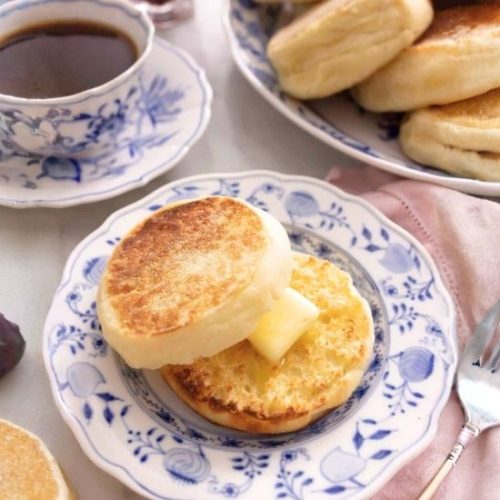
English Muffins
Delightfully soft, chewy, and golden, these homemade English Muffins are cooked on the stovetop for a crispy exterior and tender interior. Using simple pantry staples, this recipe yields about 14 muffins perfect for toasting, sandwiches, or breakfast favorites. The dough can be refrigerated overnight to develop flavor, making it an easy and flexible baking option.
Equipment
- 1 Large-sized skillet (for stovetop cooking)
- 1 Stand mixer with paddle attachment (for kneading dough)
- 1 3-inch round cutter (for shaping muffins)
- Measuring cups and spoons (for precise ingredient measurement)
- Parchment paper (for dusting and lining baking sheets)
Ingredients
- 2 ¾ cups 330g all-purpose flour
- 2 ¼ teaspoons instant yeast one packet
- 1 teaspoon salt
- 2 tablespoons granulated sugar
- ¾ cup 180ml whole milk
- ½ cup 120ml water
- 3 tablespoons 42g unsalted butter, melted
- 1 large egg at room temperature
- Cornmeal or semolina for dusting
Instructions
- Activate the Yeast: In a small bowl or heatproof measuring cup, combine the milk, water, and sugar. Warm gently (about 110°F/43°C) until lukewarm, then sprinkle the instant yeast over the surface. Stir lightly once and let it rest for 5 to 7 minutes until the mixture becomes foamy and bubbly, indicating the yeast is active.
- Prepare the Dry Ingredients: Meanwhile, whisk together the flour and salt in the bowl of a stand mixer fitted with the paddle attachment. This ensures even distribution of the salt throughout the flour.
- Combine Wet Ingredients: In a separate bowl, whisk the egg with the melted butter. Once the yeast mixture is bubbly, pour the egg-butter blend into it and stir to combine.
- Mix the Dough: Slowly add the wet ingredients into the flour mixture while running the mixer on low speed. Once all liquid is incorporated, increase the speed to medium-high and mix for 6 to 8 minutes, or until the dough is smooth, elastic, and slightly sticky.
- First Rise: Lightly oil a large bowl and transfer the dough into it, turning to coat all sides. Cover the bowl tightly with plastic wrap or a damp towel and place it in a warm, draft-free spot. Let it rise until doubled in size, approximately 1 hour. For deeper flavor, refrigerate overnight and bring to room temperature before proceeding.
- Shape the Muffins: Turn the dough out onto a lightly floured surface. Gently pat or roll it out until about ¾ inch thick. Dust two baking sheets with cornmeal or semolina. Using a 3-inch round cutter, stamp out circles and transfer them to the prepared sheets. Reroll scraps and repeat until all dough is used. Cover loosely and let the shaped muffins rise for 30 minutes in a warm spot.
- Cook on Skillet: Heat a large, heavy-bottomed skillet (cast iron preferred) over very low heat. Sprinkle a light layer of cornmeal or semolina on the surface. Place 3 or 4 muffins in the pan, cover, and cook for 5 to 6 minutes per side until golden brown and cooked through. Remove muffins and clear excess cornmeal before cooking the next batch.
- Serve and Store: Allow muffins to cool slightly before slicing with a serrated knife. Serve warm, ideally toasted. Store leftover muffins in an airtight container for 3 to 5 days or freeze for up to 3 months.
Notes
- For a chewier texture, substitute bread flour for all-purpose flour.
- Longer rising times (4-8 hours or overnight) enhance flavor and texture.
- If you don’t have a round cutter, shape muffins by hand into rounds about 3 inches in diameter.
- If muffins are too soft inside, briefly bake them in a 350°F oven for 3 minutes to finish cooking.
- Adding a small pat of butter to the skillet can prevent sticking if needed.
- Cooking on very low heat ensures the muffins cook through without burning.
- Using a serrated knife to slice prevents crushing the delicate crumb.
- Keep excess cornmeal off the skillet between batches to avoid burning.